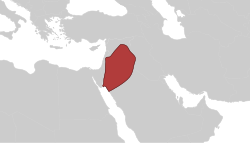Ghassanids الغساسنة | |||||||||
|---|---|---|---|---|---|---|---|---|---|
| 220–638 | |||||||||
 | |||||||||
| Status | Vassal of the Byzantine Empire | ||||||||
| Capital | Jabiyah | ||||||||
| Common languages | Old Arabic | ||||||||
| Religion | Christianity (official)[1] | ||||||||
| Government | Monarchy | ||||||||
| King | |||||||||
• 220–265 | Jafnah ibn Amr (first) | ||||||||
• 632–638 | Jabala ibn al-Ayham (last) | ||||||||
| History | |||||||||
• Established | 220 | ||||||||
| 638 | |||||||||
| |||||||||
| Historical Arab states and dynasties |
|---|
 |
The Ghassanids,[a] also known as the Jafnids,[2] were an Arabian tribe. Originally from South Arabia, they migrated to the Levant in the 3rd century and established what would eventually become a Christian kingdom under the aegis of the Byzantine Empire,[3][4] as their society merged with local Chalcedonian Christianity and was largely Hellenized.[5] However, some of the Ghassanids may have already adhered to Christianity before they emigrated from South Arabia to escape religious persecution.[4][6]
As a Byzantine vassal, the Ghassanids participated in the Byzantine–Sasanian Wars, fighting against the Sasanian-allied Lakhmids, who were also an Arabian tribe, but adhered to the non-Chalcedonian Church of the East.[3][6] The lands of the Ghassanids also acted as a buffer zone protecting lands that had been annexed by the Romans against raids by Bedouins.[citation needed]
After just over 400 years of existence, the Ghassanid kingdom fell to the Rashidun Caliphate during the Muslim conquest of the Levant. A few of the tribe's members then converted to Islam, while most dispersed themselves amongst Melkites and Syriacs in what is now Jordan, Israel, Syria, Palestine, and Lebanon.[4]
- ^ Maalouf, Tony (2005). Arabs in the Shadow of Israel: The Unfolding of God's Prophetic Plan for Ishmael's Line. Kregel Academic. p. 23. ISBN 9780825493638.
- ^ Fisher 2018.
- ^ a b Cite error: The named reference
Hobermanwas invoked but never defined (see the help page). - ^ a b c Bowersock, G. W.; Brown, Peter; Grabar, Oleg (1998). Late Antiquity: A guide to the Postclassical World. Harvard University Press. ISBN 9780674511705.
Late Antiquity - Bowersock/Brown/Grabar.
- ^ "Deir Gassaneh".
- ^ a b Bury, John (January 1958). History of the Later Roman Empire from the Death of Theodosius I to the Death of Justinian, Part 2. Courier Dover Publications. ISBN 9780486203997.
Cite error: There are <ref group=lower-alpha> tags or {{efn}} templates on this page, but the references will not show without a {{reflist|group=lower-alpha}} template or {{notelist}} template (see the help page).